2018 HONDA CLARITY PLUG IN HYBRID tow
[x] Cancel search: towPage 461 of 591
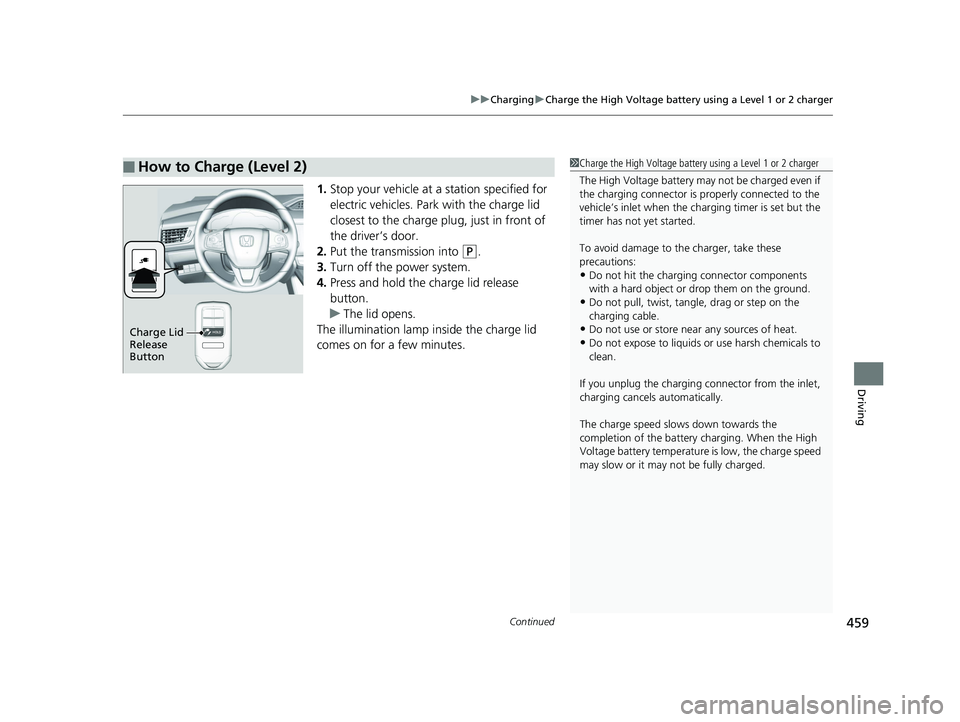
Continued
459uu Charging u Charge the High Voltage battery using a Level 1 or 2 charger
Driving
1. Stop your vehicle at a station specified for
electric vehicles. Park with the charge lid
closest to the charge plug, just in front of
the driver’s door.
2. Put the transmission into ( P
.
3. Turn off the power system.
4. Press and hold the charge lid release
button.
u The lid opens.
The illumination lamp inside the charge lid
comes on for a few minutes.■ How to Charge (Level 2) 1 Charge the High Voltage battery using a Level 1 or 2 charger
The High Voltage battery may not be charged even if
the charging connector is properly connected to the
vehicle’s inlet when the charging timer is set but the
timer has not yet started.
To avoid damage to th e charger, take these
precautions:
• Do not hit the charging connector components
with a hard object or drop them on the ground.
• Do not pull, twist, tangle, drag or step on the
charging cable.
• Do not use or store near any sources of heat.
• Do not expose to liquids or use harsh chemicals to
clean.
If you unplug the charging connector from the inlet,
charging cancels automatically.
The charge speed slows down towards the
completion of the battery charging. When the High
Voltage battery temperature is low, the charge speed
may slow or it may not be fully charged.Charge Lid
Release
Button18 CLARITY PHEV CSS-31TRW6000.book 459 ページ 2017年8月31日 木曜日 午後2時49分
Page 475 of 591
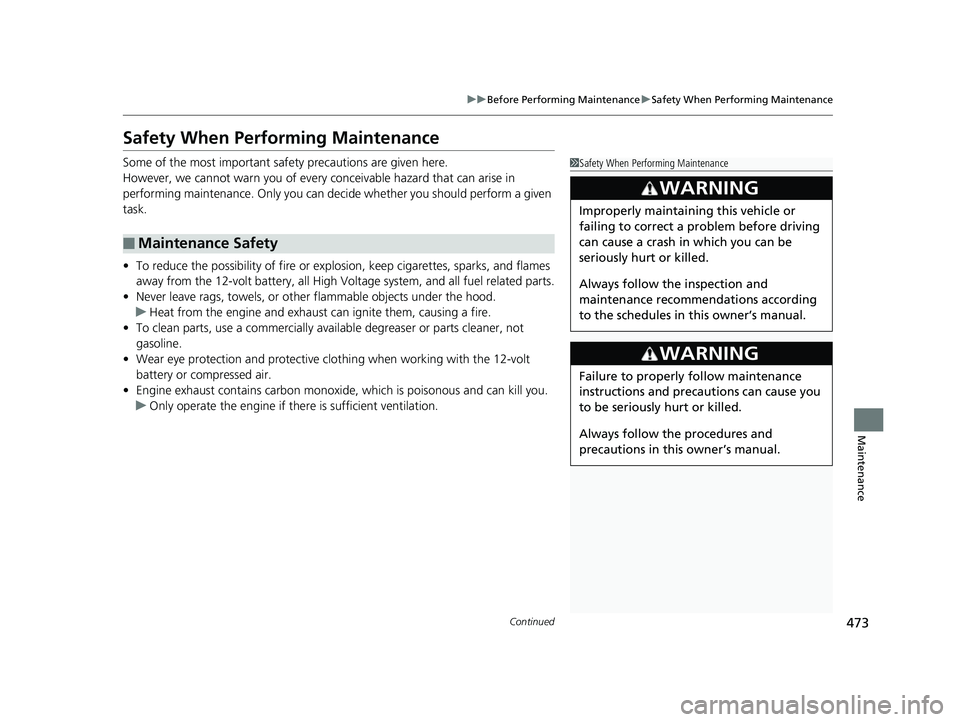
473uu Before Performing Maintenance u Safety When Performing Maintenance
Continued
Maintenance
Safety When Performing Maintenance Some of the most important safe ty precautions are given here.
However, we cannot warn you of every conceivable hazard that can arise in
performing maintenance. Only you can decide whether you should perform a given
task.
• To reduce the possibility of fire or explos ion, keep cigarettes, sparks, and flames
away from the 12-volt battery, all High Volt age system, and all fuel related parts.
• Never leave rags, towels, or other flammable objects under the hood.
u Heat from the engine and exhaust can ignite them, causing a fire.
• To clean parts, use a co mmercially available degreaser or parts cleaner, not
gasoline.
• Wear eye protection and pr otective clothing when working with the 12-volt
battery or compressed air.
• Engine exhaust contains carbon monoxide, which is poisonous and can kill you.
u Only operate the engine if th ere is sufficient ventilation.■ Maintenance Safety 1 Safety When Performing Maintenance
3
WARNING Improperly maintaining this vehicle or
failing to correct a pr oblem before driving
can cause a crash in which you can be
seriously hurt or killed.
Always follow the inspection and
maintenance recommendations according
to the schedules in this owner’s manual.
3
WARNING Failure to properly follow maintenance
instructions and prec autions can cause you
to be seriously hurt or killed.
Always follow the procedures and
precautions in this owner’s manual.18 CLARITY PHEV CSS-31TRW6000.book 473 ページ 2017年8月31日 木曜日 午後2時49分
Page 483 of 591
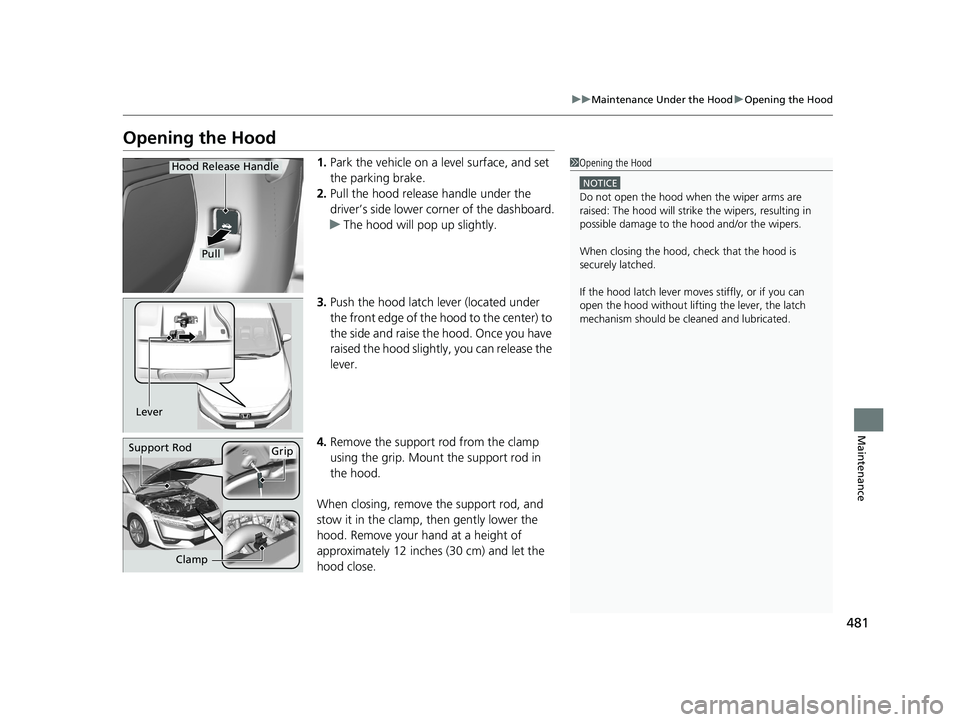
481uu Maintenance Under the Hood u Opening the Hood
Maintenance
Opening the Hood 1. Park the vehicle on a level surface, and set
the parking brake.
2. Pull the hood release handle under the
driver’s side lower corner of the dashboard.
u The hood will pop up slightly.
3. Push the hood latch lever (located under
the front edge of the hood to the center) to
the side and raise the hood. Once you have
raised the hood slightly , you can release the
lever.
4. Remove the support rod from the clamp
using the grip. Mount the support rod in
the hood.
When closing, remove the support rod, and
stow it in the clamp, then gently lower the
hood. Remove your hand at a height of
approximately 12 inches (30 cm) and let the
hood close. 1 Opening the Hood NOTICE
Do not open the hood when the wiper arms are
raised: The hood will strike the wipers, resulting in
possible damage to the hood and/or the wipers.
When closing the hood, check that the hood is
securely latched.
If the hood latch lever moves stiffly, or if you can
open the hood without lifti ng the lever, the latch
mechanism should be cl eaned and lubricated.PullHood Release Handle
Lever
Support Rod
Grip
Clamp18 CLARITY PHEV CSS-31TRW6000.book 481 ページ 2017年8月31日 木曜日 午後2時49分
Page 485 of 591
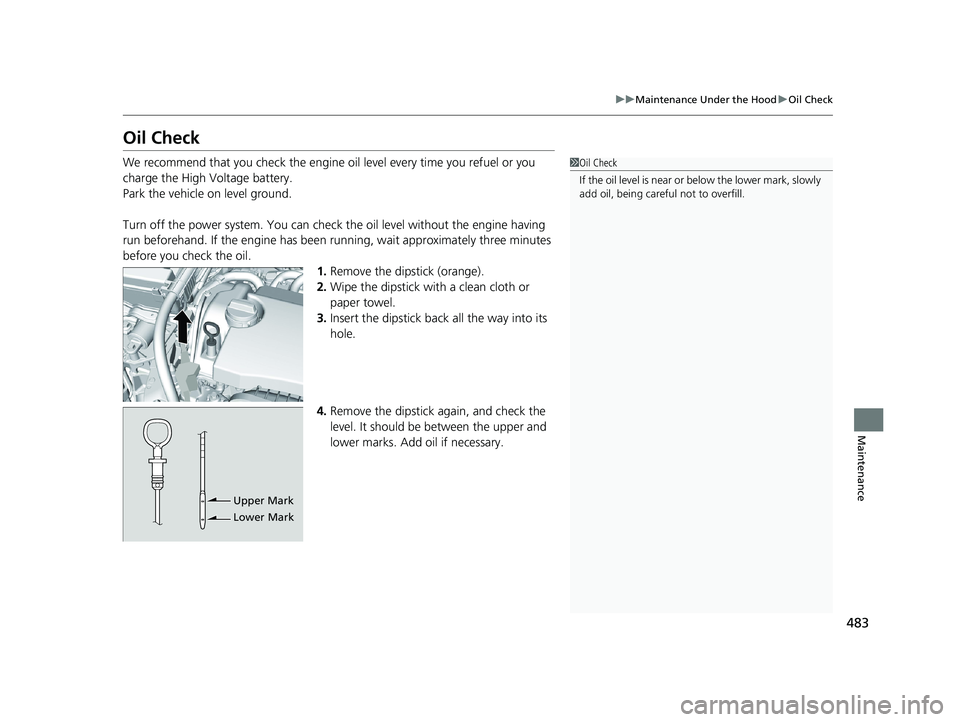
483uu Maintenance Under the Hood u Oil Check
Maintenance
Oil Check We recommend that you check the engine oil level every time you refuel or you
charge the High Voltage battery.
Park the vehicle on level ground.
Turn off the power system. You can check the oil level without the engine having
run beforehand. If the engine has been ru nning, wait approxim ately three minutes
before you check the oil.
1. Remove the dipstick (orange).
2. Wipe the dipstick with a clean cloth or
paper towel.
3. Insert the dipstick back all the way into its
hole.
4. Remove the dipstick again, and check the
level. It should be between the upper and
lower marks. Add oil if necessary. 1 Oil Check
If the oil level is near or below the lower mark, slowly
add oil, being carefu l not to overfill.
Upper Mark
Lower Mark18 CLARITY PHEV CSS-31TRW6000.book 483 ページ 2017年8月31日 木曜日 午後2時49分
Page 510 of 591
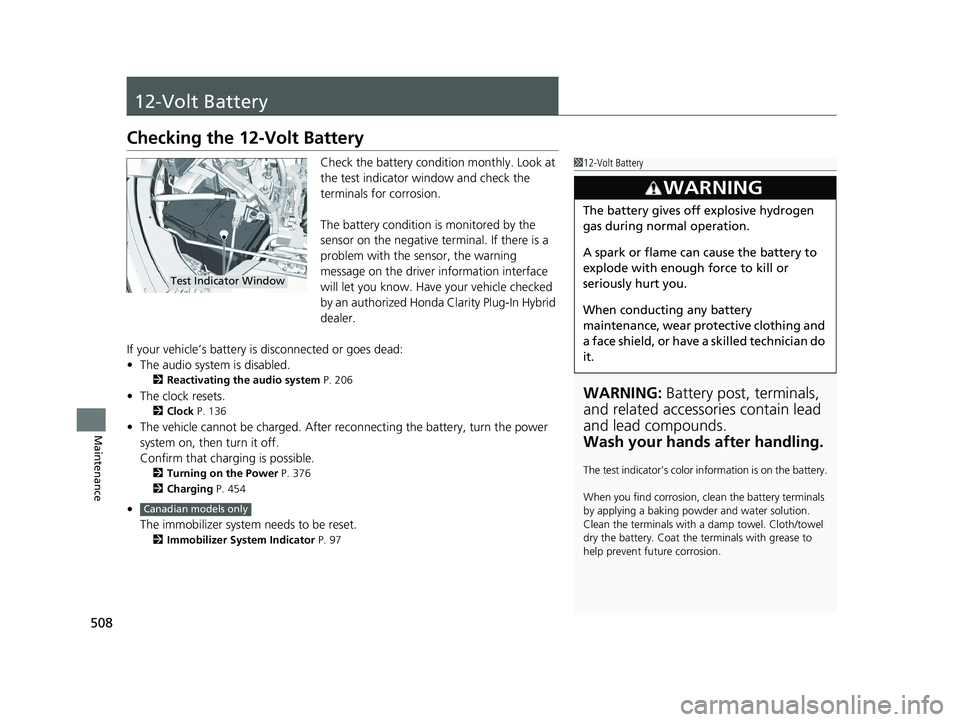
508
Maintenance 12-Volt Battery Checking the 12-Volt Battery Check the battery condition monthly. Look at
the test indicator window and check the
terminals for corrosion.
The battery condition is monitored by the
sensor on the negative terminal. If there is a
problem with the sensor, the warning
message on the driver information interface
will let you know. Have your vehicle checked
by an authorized Honda Clarity Plug-In Hybrid
dealer.
If your vehicle’s battery is disconnected or goes dead:
• The audio system is disabled. 2 Reactivating the audio system P. 206
• The clock resets. 2 Clock P. 136
• The vehicle cannot be charged. After re connecting the batte ry, turn the power
system on, then turn it off.
Confirm that charging is possible. 2 Turning on the Power P. 376
2 Charging P. 454
•
The immobilizer system needs to be reset. 2 Immobilizer System Indicator P. 97 1 12-Volt Battery
WARNING: Battery post, terminals,
and related accessories contain lead
and lead compounds.
Wash your hands after handling. The test indicator’s color in formation is on the battery.
When you find corrosion, cl ean the battery terminals
by applying a baking powder and water solution.
Clean the terminals with a damp towel. Cloth/towel
dry the battery. Coat the terminals with grease to
help prevent future corrosion.3
WARNING The battery gives off explosive hydrogen
gas during normal operation.
A spark or flame can cause the battery to
explode with enough force to kill or
seriously hurt you.
When conducting any battery
maintenance, wear prot ective clothing and
a face shield, or have a skilled technician do
it.Test Indicator Window
Canadian models only18 CLARITY PHEV CSS-31TRW6000.book 508 ページ 2017年8月31日 木曜日 午後2時49分
Page 523 of 591
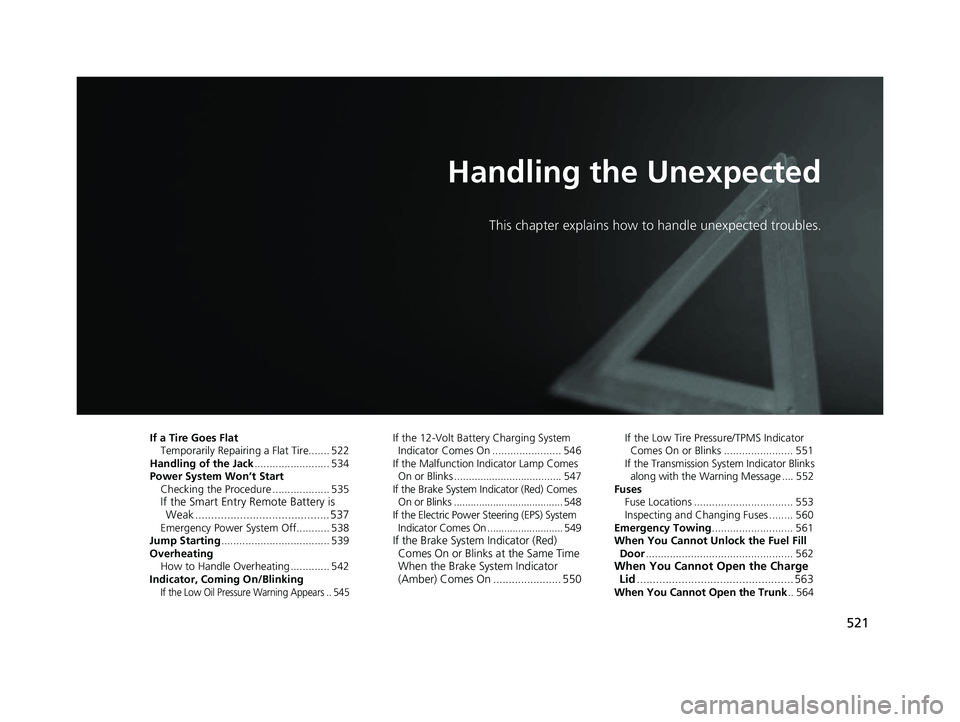
521Handling the Unexpected This chapter explains how to handle unexpected troubles.
If a Tire Goes Flat
Temporarily Repairi ng a Flat Tire....... 522
Handling of the Jack ......................... 534
Power System Won’t Start
Checking the Procedure ................... 535
If the Smart Entry Remote Battery is
Weak .......................................... 537
Emergency Power System Off........... 538
Jump Starting .................................... 539
Overheating
How to Handle Overheating ............. 542
Indicator, Coming On/Blinking
If the Low Oil Pressure Warning Appears .. 545 If the 12-Volt Battery Charging System
Indicator Comes On ....................... 546
If the Malfunction Indicator Lamp Comes
On or Blinks ..................................... 547
If the Brake System Indicator (Red) Comes
On or Blinks ....................................... 548
If the Electric Power Steering (EPS) System
Indicator Comes On ........................... 549
If the Brake System Indicator (Red)
Comes On or Blinks at the Same Time
When the Brake System Indicator
(Amber) Comes On ...................... 550 If the Low Tire Pressure/TPMS Indicator
Comes On or Blinks ....................... 551
If the Transmission System Indicator Blinks
along with the Warning Message .... 552
Fuses
Fuse Locations ................................. 553
Inspecting and Changing Fuses ........ 560
Emergency Towing ........................... 561
When You Cannot Unlock the Fuel Fill
Door ................................................. 562
When You Cannot Open the Charge
Lid ................................................. 563
When You Cannot Open the Trunk .. 56418 CLARITY PHEV CSS-31TRW6000.book 521 ページ 2017年8月31日 木曜日 午後2時49分
Page 524 of 591

522
Handling the Unexpected If a Tire Goes Flat Temporarily Repairing a Flat Tire If the tire has a large cut or is otherwise se verely damaged, you will need to have the
vehicle towed. If the tire only has a smal l puncture, from a nail for instance, you can
use the temporary tire repair kit so that you can drive to the nearest service station
for a more permanent repair.
If a tire goes flat while driving, grasp the steering wheel firmly, and brake gradually
to reduce speed. Then stop in a safe place.
1. Park the vehicle on a firm, level, and non-slippery surface and apply the parking
brake.
2. Change the gear position to ( P
.
3. Turn on the hazard warning lights an d set the power mode to VEHICLE OFF
(LOCK). 1 Temporarily Repairing a Flat Tire
The kit should not be used in the following situations.
Instead, contact an authorized Honda Clarity Plug-In
Hybrid dealer or roadside assistance to have the
vehicle towed.
• The tire sealant has expired.
• More than one tire is punctured.
• The puncture or cut is larger than 3/16 inch (4 mm).
• The tire side wall is da maged or the puncture is
outside the contact area.
• Damage has been caused by driving with the tire
extremely under inflated.
• The tire bead is no longer seated.
• The rim is damaged.
Do not remove a nail or screw that punctured the
tire. If you remove it from the tire, you may not be
able to repair the puncture using the kit.When the puncture is: Kit Use
Smaller than 3/16 inch
(4 mm) Yes
Larger than 3/16 inch
(4 mm) NoContact
Area18 CLARITY PHEV CSS-31TRW6000.book 522 ページ 2017年8月31日 木曜日 午後2時49分
Page 529 of 591
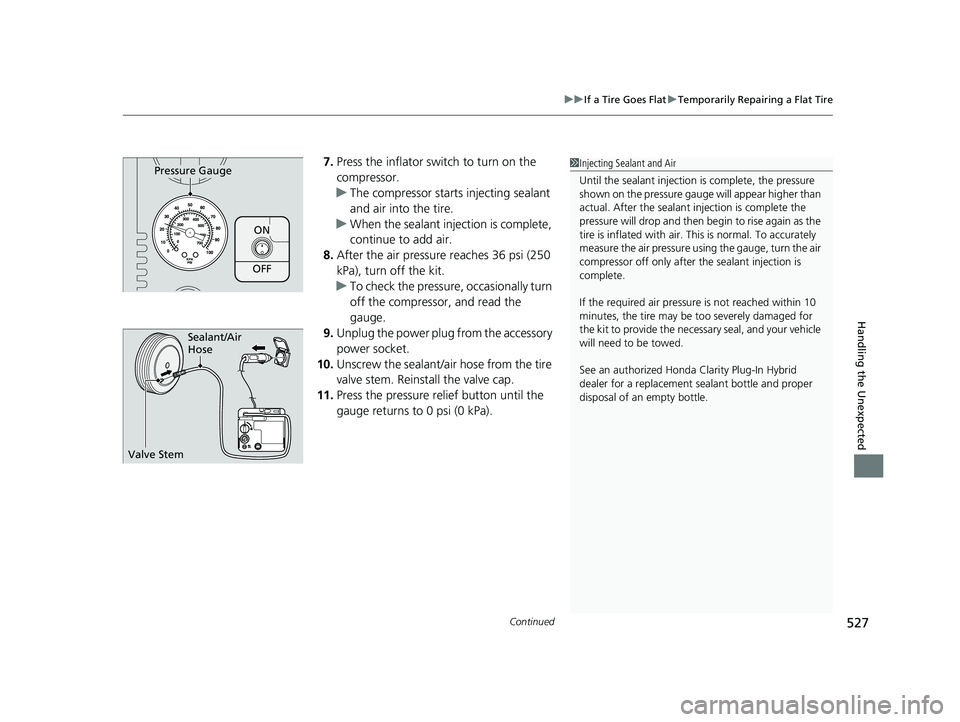
Continued
527uu If a Tire Goes Flat u Temporarily Repairing a Flat Tire
Handling the Unexpected
7. Press the inflator switch to turn on the
compressor.
u The compressor starts injecting sealant
and air into the tire.
u When the sealant injection is complete,
continue to add air.
8. After the air pressure reaches 36 psi (250
kPa), turn off the kit.
u To check the pressure, occasionally turn
off the compressor, and read the
gauge.
9. Unplug the power plug from the accessory
power socket.
10. Unscrew the sealant/ai r hose from the tire
valve stem. Reinstall the valve cap.
11. Press the pressure relief button until the
gauge returns to 0 psi (0 kPa).ON
OFFPressure Gauge 1 Injecting Sealant and Air
Until the sealant injection is complete, the pressure
shown on the pressure gauge will appear higher than
actual. After the sealant injection is complete the
pressure will drop and then begin to rise again as the
tire is inflated with air. This is normal. To accurately
measure the air pressure usi ng the gauge, turn the air
compressor off only after the sealant injection is
complete.
If the required air pressure is not reached within 10
minutes, the tire may be too severely damaged for
the kit to provide the necessa ry seal, and your vehicle
will need to be towed.
See an authorized Honda Clarity Plug-In Hybrid
dealer for a replacement sealant bottle and proper
disposal of an empty bottle.Sealant/Air
Hose
Valve Stem18 CLARITY PHEV CSS-31TRW6000.book 527 ページ 2017年8月31日 木曜日 午後2時49分